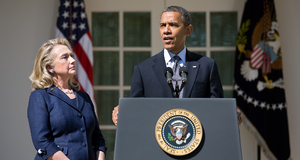The Obama PresidencyPredicting the Fate of the Judiciary After ObamaAftermath of the 2014 Midterm ElectionsIn the recent midterm elections, Republicans gained a very comfortable majority in government. They gained control of the Senate, maintained control of the House of Representatives, and the number of Republican governors also outweighs the number of Democratic governors. This power shift essentially guarantees consequences extending through the remainder of President Obama’s tenure, and possibly indicating a continued shift in the 2016 presidential elections. The Next Two Years and BeyondRussell Wheeler had speculated that if the Republicans gained control of the Senate during the midterm elections, the rate at which confirmations are processed would slow significantly. He observed that during recent eight-year presidencies, a similar pattern occurred; though Presidents Reagan, Clinton, and George W. Bush weren’t operating during a time of hyperpolarization as we are now. As Wheeler says, the “President’s party would lose control of the confirmation machinery.”29 There are currently eight vacancies on the Circuit Courts, with five of the openings created by Republican appointees. Additional vacancies could be created if eligible judges choose to take senior status. If Obama would fill the current vacancies there would not be any additional shift, but it would make the margin much slimmer and increase the proportion of Democratic appointees overall. Moreover, if he were to be able to fill the spots of senior judges there would be an opportunity to cause a shift in two more Circuit Courts.30 Given the likelihood of an increased stalemate, though, this is a very unlikely situation.The results of the recent midterm elections could prove to be indicative of the outcome of the 2016 presidential election, which in turn will have a great impact on the judiciary. Republicans are hopeful that the power shift indicates an easy victory for the GOP candidate, while others aren’t so quick to make assumptions. President Obama has become the third president in a row to enter office with his party in control of both houses, and who will leave office with control of neither house; Presidents Clinton and George W. Bush faced similar fates. While they did not face such polarization as Congress has seen under President Obama, these significant power shifts have become routine over the last two decades.31 And following their eight-year reigns, a member of the opposing party assumed the presidency. A Pew poll conducted in late October, prior to the midterm elections, showed that voters think Republicans to do better with the threat of terrorism, the budget deficit, the economy, and immigration. In healthcare, the Democrats remained ahead but by a significantly lesser margin.32 These issues will be incredibly important in the coming elections, and much of public perception regarding the ability of the Democratic Party will come from how President Obama handles policy in these areas over the coming two years. Particularly, the United States’ handling of the situation with the Islamic State (ISIS) will be a significant point of judgment.33 Following the change to the filibuster rules in 2013, President Obama addressed the public and said: What’s at stake here is not my ability to fulfill my Constitutional duty. What’s at stake is the ability of any President to fulfill his or her Constitutional duty. Public service is not a game…the consequences of action or inaction are very real.34 He and the Democrats may regret this change come 2016 if a Republican does indeed take office. Ezra Klein speculates in her article for The Washington Post that with this precedent, a Republican president may try to remove the filibuster rules all together.35 I think it is quite likely that President Obama and the Senate Democrats will regret their decision to remove the filibuster from judicial nominations if and when they are the ones that are being silenced. In the meantime, during the remainder of the Obama Presidency, it is very probable that we will see in increase in the use of the veto by the home-state Senators.36 The results of the midterm elections show that the political party preferences of states are not set in stone, and are changing rapidly. For example, Wisconsin, Michigan, and Maryland have all been historically “blue” states.37 In the gubernatorial races in all three of these states, also taking place this year, Republican governors were elected.38 This makes the 2016 Presidential Election difficult to predict. With many states wavering on the edge of supporting a political party, there is a lot of room for change in the next two years. What This Means for the Supreme CourtPotential RetireesThere are several members of the Supreme Court that could be reasonably expected to retire in the near future. On the left side of the bench, both Justice Ruth Bader Ginsburg and Justice Stephen Breyer are approaching potential retirement. On the right, Justices Scalia and Kennedy are getting older as well. If President Obama is given another opportunity to appoint a Supreme Court Justice, he is likely to face significant opposition as he has in recent years with his lower court appointments. As the most senior Justice on the bench, in age, Justice Ginsburg (81 years) is most likely the next to retire. According to recent interviews, she has no plans to retire in the near future and says she will continue on the bench “as long as [she] can do the job full steam.”39 That day might be coming sooner than she anticipated as she has just undergone heart surgery. Though her resilience is worth noting, as she has remained on the bench through two bouts of cancer.40 She is incredibly aware of the hyperpolarized environment in Congress and recognizes that President Obama would have difficulties appointing her replacement if she were to retire now. In an interview with Elle Magazine, Justice Ginsburg says: Who do you think President Obama could appoint at this very day, given the boundaries that we have? If I resign at any time this year, he could not successfully appoint anyone I would like to see in the Court… anybody who thinks that if I step down, Obama could appoint someone like me, they’re misguided.41 President Obama disagrees with her, and believes that the Senate would act differently with a Supreme Court nomination than with nominations to the lower courts. He says because the confirmations take place more in the public eye Republicans would be deterred from their delay and obstruction tactics.42 Randall Kennedy, a scholar on judicial nominations, agrees and explains that even the Republicans that have been the most staunchly opposed to Obama’s nominees holds the Supreme Court to a different standard and would refrain from delaying.43 I think that Ginsburg is right on track with her logic, and that President Obama is a bit naïve thinking otherwise. The Republicans have made it very clear that they will stand against Obama’s initiatives, and now that they will have the Senate Majority there is no reason for them to back down. Furthermore, there is the possibility that President Obama will not have the opportunity to nominate the next Supreme Court. If that proves to be the case, the next President of the United States will likely be able to appoint two, if not three or four, Justices to the Supreme Court bench. As mentioned, the 2014 Midterm Elections indicate that there is a strong chance that a Republican will be elected in the 2016 Presidential Elections. We will see a huge ideological shift on the Supreme Court if a Republican president names multiple Justices. It is very unlikely that Justice Ginsberg and Justice Breyer would be able to hold out for the possible election of a Democrat if a Republican president were to serve two terms. This would mean that two of the Court’s left-leaning Justices would be replaced with much more conservative Justices. Additionally, if the older right-leaning Justices, Kennedy and Scalia retire during that time they will be replaced with equally conservative Justices. This would tilt the balance of the Supreme Court so that there were seven conservative Justices to the two remaining liberal Justices. As Randall Kennedy has suggested, it would have been best for both Justices Ginsburg and Breyer to retire at the end of the 2011 Supreme Court term. Choosing when to retire is one of the benefits of a lifetime appointment. He claims that it is within a Justice’s lawful right to retire at a time when there is a presidential administration that would most likely replace him or her with someone maintaining a similar judicial philosophy.44 At the time he claimed that this does not serve to politicize the courts, however I would argue that it does highlight the potential for polarization and increased politicization of the courts. Had Justices Ginsberg and Breyer retired before the end of Obama’s first term, when the Democrats maintained a majority in the Senate, they both undoubtedly would have been replaced with younger, left-of-center Justices that would go on to serve on the Supreme Court for many years and at least maintain the current balance of ideology. It would have been the best strategy, politically, for both Justices. District Court BreakdownIt is not yet 2015, and Obama has not yet made any judicial appointments under the Republican-controlled Senate. But looking at President Obama’s District Court appointees helps to analyze the kinds of nominees that he has been able to confirm so far, despite the strong Republican opposition. Because we can only expect this opposition to grow stronger, identifying the seemingly acceptable characteristics will be helpful going forward. Sheldon Goldman’s research has successfully broken down many qualities of the District Court appointees under Obama’s Administration. Fifty-seven of Obama’s appointees have fallen into the traditional category. The remaining eighty-four are non-traditional. A majority of the non-traditional appointees came from either state courts or the U.S. Magistrate’s Office; on the other hand, traditional appointees to the District Courts were more likely to come from careers in private practice law. Only one-fifth of the non-traditional appointees lacked prior judicial experience, whereas a larger one-third of traditional appointees lacked such experience.45 Furthermore, five of Obama’s District Court appointees have been Republicans.46 This goes to show his willingness to heed the suggestions of Senators when making nominations as the District Court level, and should draw criticism towards Republican Senators for failing to make recommendations given this level of cooperation. Predicting the Next JusticePresident Obama has tried to refrain from the deep-rooted ideological debates that have often surrounded judicial nominations and confirmations. As Jeffrey Toobin says, “Claims for [Obama’s] judges are grounded in their personal integrity and professional competence.”[47] Moreover, Obama makes an interesting observation about the Republican Party as a whole: The bulk of my nominees, twenty years ago or even ten years ago, would have been considered very much centrists… [This] has to do more with a shift in the Republican Party.48 This suggests that the Democratic appointees have remained a similar level of moderately liberal, while the Republican standard has grown increasingly conservative. If Obama is to successfully appoint a Supreme Court Justice, given the opportunity to do so, his nominee will have to look a bit different as well. President Obama would most likely seek to nominate another Justice of what he calls a “centrist” perspective, so as not to disrupt the current ideological balance on the Supreme Court. It is worthwhile to note again that the filibuster changes did not apply to Supreme Court confirmation hearings. In order to gain unilateral support in Congress, the nominee should meet an additional set of criteria that will help to get Republicans on board. To start, the nominee should be more traditional – a straight, white male. A traditional nominee will by nature be a less controversial option. Even though at the District Court level traditional nominees did not need as much direct experience in the courts as non-traditional nominees, a traditional nominee for a seat on the Supreme Court should have a significant amount of experience. This will give likely result in a higher competence rating from the American Bar Association and will not provide Republicans with a source of contention. I would recommend that experience come from serving on the Circuit or District Court benches, or from significant experience arguing in front of the Supreme Court itself as an attorney. Nominees should not be actively involved with political parties. As Benjamin Wittes discusses in his book, Confirmation Wars, the confirmation hearings themselves have become extremely polarized events. Active political participation gives the opposition more material to use against the nominee. Senators will try to extrapolate how a nominee would rule on controversial cases if he or she were successfully appointed.49 This is best avoided by selecting a nominee that has not been open about highly polarized issues or devoted time campaigning for candidates that have opinions about highly polarized issues.Continued on Next Page » Suggested Reading from Inquiries Journal
Inquiries Journal provides undergraduate and graduate students around the world a platform for the wide dissemination of academic work over a range of core disciplines. Representing the work of students from hundreds of institutions around the globe, Inquiries Journal's large database of academic articles is completely free. Learn more | Blog | Submit Latest in Political Science |
















